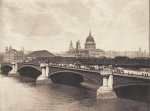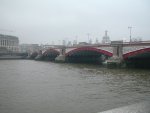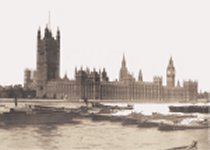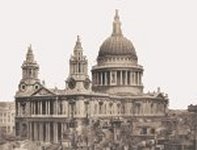|
|
The "Square Mile"
The"City", or the "Square Mile" is now the commercial heart of London. Built on the site of the original Roman settlement its size is still governed by the river on one side and the approximate line of the walls on the landward side. Extending form Blackfriars' Bridge in the west to the striking Tower Bridge in the East and then inland as far as London Wall. The City hums with activity during the business day and then falls almost silent at other times, as there are few residents. We will start our exploration at the Eastern end, Blackfriars' Bridge.
|
BLACKFRIARS BRIDGE.
Blackfriars Bridge, 1,272 feet long and 80 feet broad, is made of iron, its five arches
being supported by granite piers; it cost £320,000, was built by Cubitt, and was opened
in 1869. Parallel with it, and spoiling whatever good effect it might possess, runs the London,
Chatham and Dover railway bridge; and the sloping roof visible in our picture is that of St. Paul's
station. But no better view of the grandly proportioned dome and towers of St. Paul's Cathedral
can be obtained than from Blackfriars Bridge, which, by the bye, owes its name to an old monastery
situated on the bank of the river, and dating from the end of the twelfth century. The bridge which
it superseded was of stone, and was built in 1769.
|

|
|

|
Blackfriar's Bridge still copes with the modern rush of traffic - a tribute to its Victorian builders. Not so the old railway bridge seen on the original photograph. The piers for it remain, but a new bridge, and a new station (Blackfriars rather than St Paul's) were built just to the east of the old. The view of St Paul's is still blocked.
Looking at the skyline we can see one of the big changes form Victorian days, the high rise buildings of the City's commercial district.
|
|
|





